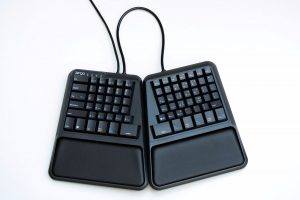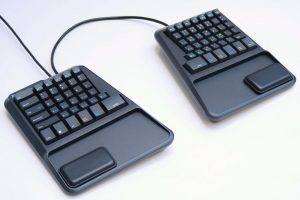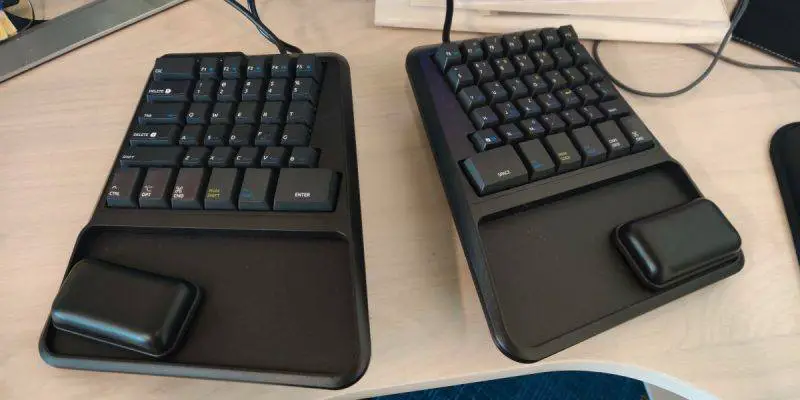Over the past month we have been testing a really exciting and truly innovative ergonomic keyboard, the Freedom from Zergotech which bills itself as a programmable, mechanical, split, ergonomic semi-orthogonal keyboard. Whew. That’s a lot to unpack and we’ll get to that in a bit.
Unpacking and First Impressions
First a disclaimer. We were lucky to get a pre-production version. All of the pictures I take are of this pre production model. I will add a few pictures at the end of the final version.
Let’s start from the unpacking. As you will see, this keyboard has wrist sliders! I looked for those first, curious as to how they worked. I found them and got the keyboard unpacked. Here are a couple of photos unboxing this Australian-designed keyboard. Our first reactions were a keyboard that appears well made and felt rock solid in my hands. And of course before even plugging in, I had to give the sliding palm rests a go. Here you can see a picture of the two options included with each keyboard: low profile and high profile. I like the lower padding better. These pads have a slippery bottom which slides freely within that wrist rest area.

Here is the keyboard with my preferred lower profile wrist slider:

The Sliding Wonder and the Basics
Ok, first off what makes this keyboard really stand out is a novel and innovative sliding palm rests system. As you can see from this gif I snagged from their website, as you type away, the wrist rest area is designed to keep your hands and fingers relaxed as you hover around the keyboard.

Brilliant, absolutely brilliant! No matter how small your keyboard and large your hands, you need to hover over different parts of your keyboard. As an engineer, I use every key it seems like a composer would use every part of a symphony. Essentially, the wrist area is made of hard, slippery plastic and the keyboard comes with two sets of small padded pads with slippery feet (this is Teflon PTFE material) allowing your wrists to rest on the padded pads and the pads move freely in the wrist rest area. One set has minimal padding and the other lots of padding. (the sliders have two profiles – slim profile and tall profile. The slim profile comes standard with the keyboard. The taller sliders are intended to be purchased as an accessory for use with taller standard keyboards, such as the height of ergonomic mechanical keyboards.) For my comfort, I preferred the height of the extra padding. For those that don’t want to use this system, the keyboard also comes with traditional padded wrist rests which turn the wrist rest area into a traditional non-sliding padded area. They have worldwide patents pending on this design. My favorite part of the sliding palms rests is the ability to easily slide to the top and bottom rows of the keyboard without needing to lift or move the position of your hands.
OK, taking a step back, this is a USB corded keyboard so you will need to have a free USB port on your computer. As of now, this is the only option. Over the years, I have leaned towards USB based keyboards as wireless keyboards from time to time have trouble pairing and even if not common it’s common enough that the corded solution is slightly preferred. The company makes a Mac and a Windows version. I got the Mac version and testing it with a USB C adapters on a 2018 Macbook Pro using the Mac and Windows boot as well as a 2018 Google Pixel Chromebook in both Chrome and Linux. I’ll jump right to our compatibility conclusion. The keyboard worked like a charm across all four operating systems.

As with innovative keyboards, one question you need to ask yourself is whether you will invest the time needed to learn the new keyboard so you can at least get back to your normal typing speed quickly. This keyboard uses a semi-orthogonal design that is not too radical. After about a day’s worth of typing I was about 90% back to my normal typing speed. A fully orthogonal layout means all the keys are aligned vertically like the Ergodox. They called this a “semi orthogonal” design since only the top half is aligned vertically but the lower half (home row and bottom row) is relatively unchanged, hence the offset bottom row.
The company claims you can get back to full typing speed in days. I agree. After three days, I was typing with no problems at my normal typing speed. The one thing that took me the longest to get used to was having the enter key and space keys adjacent to each other. This makes a ton of sense though. You hit enter after every sentence so a thumb always on the enter key is faster and healthier than moving a pinky to hit enter. My enter key pressing time really went down.

Keyboard Features
First of all this is a split keyboard that allows you to separate the left and right halves up to 50 cm and at any angle that is most comfortable. Personally I only recommend split keyboards to friends and family so I am a bit biased by this design but once you start using split keyboards, you too will be an advocate. By having control over how far you want to split the halves this keyboard should accommodate nearly everyone. I like mine about 2.5 inches apart which naturally opens my chest, lowers my shoulders, and straightens my back as I type. When I have to use straight keyboards, I can feel the stress build up in minutes!
You have two tenting options. The keyboard normally rests at an angle of 5° and has feet you can prop up to increase that angle to 12° from center. I used to use lower angle tenting options but now I like the 12° setup.

You can also pop up two feet at the front of the keyboard or two feet at the back. Popping the front will provide a declined angle and is useful for people who sits at a higher position relative to the desk. If you sit lower relative to your desk, the incline would be more ergonomic.

The other day here in Hawaii, I saw a bumper sticker with r/mk. That is the shorthand for the Reddit community for mechanical switch keyboards. Some dedicate shelves in their homes where they can display all of their keyboards! There are literally millions of fans worldwide who have a passion for keyboard with mechanical switches. Chances are, if you are using a relatively inexpensive keyboard, it does not have mechanical switches. The biggest advantage of a mechanical switch and a membrane switch is the mechanical ones more tactical, responsive, comfortable, and last forever. You can choose between Kailh Box White switches which are more “clicky” or Kalih Box Brown which are more Tactile. I got the Browns. You can check out their site for a video demo of the switches if you want more info.
Customizing the Keyboard Layouts
As with all high end keyboards, this one is programmable so you can customize the keys exactly how you want them to work. If you want to swap the Space and Enter keys, you would use a key stroke combination to initiate and complete the swapping. See their Programming Guide for more details.By the way, swapping keys totally makes sense. If you are right handed, you most likely will use your right thumb to hit space so it should be on the right side. And vice versa if you are left handed. In fact, you can order a Freedom with blank keys so you can map them exactly how you want them to be.
The programming of the keyboard is intuitive and easy to use. There is no software to install and all the programming is done by a set of macros that print instructions in a normal text editor. This means no drivers, software, or convoluted processes to get the layout you want. You can map any key to any layer, including combination and hot keys.
The Freedom also comes with two built in layouts. The Function layout is enabled when you press the FN key or FN Lock key. I LOVE This layer and use it all the time. I use my left thumb to press the FN key and then my fingers to move the cursor around with arrow keys or page up and down, all without moving my hand one iota. Once you get used to this, moving around without a mouse is a game changer. I also use the copy-cut-paste-undo keys a ton.

There is also a number layout that is engaged by pressing the Num Shift or Num Lock keys and then a number pad is enabled on the right side. I don’t really need this layout but for those that enter a ton of numbers, you no longer need a dedicated number pad.

Read More about the Ergonomics
The Zergo website has a really good page that covers in details some of the ergonomic challenges you want to solve with an ergonomic keyboard. Rather than summarize all of it here, give this page on solving common keyboard ergonomic challenges a read.
Bottom Line
This is the most asked about keyboard I have ever tested. My office mates asked me about that “sliding thing” and if it worked. A few tried it. All agreed it is a brilliant design addition to a keyboard. I am going to use this full time at my office so hope to have a longer term review but for now let me summarize by saying this is an excellent keyboard. For power users you get all of the features you need like layers, macros, and swapping keys. For those with the ergonomic priority, this keyboard checks all of our boxes for one that we can recommend wholeheartedly. Other keyboards may have more tenting and angle options but this one has enough to satisfy most folks. For those that don’t want to learn a new layout, this one is decent in that you’ll probably have to invest a few days of sloppy typing to get back to full speed. The only person who may be a little disappointed will be your accountant. This keyboard is not cheap if you are used to buying standard keyboards but it is well priced over competing models. Overall we recommend this keyboard.
Additional Pictures from the Manufacturer
Since we got a pre-production model, the manufacturer sent us these photos of the final production model.















- Your Complete Guide To The Best Ergonomic Kneeling Chairs - March 25, 2024
- 5 Best Ergonomic Wine Bottle Openers - March 4, 2024
- Handshoe Mouse Review - January 23, 2024




